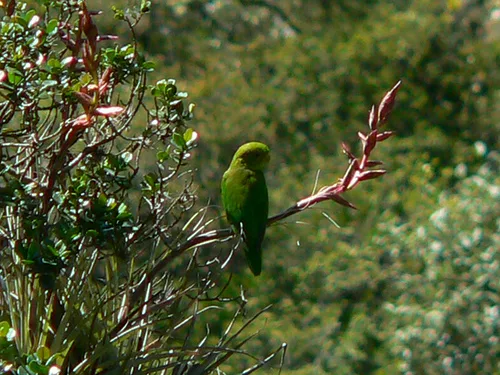
Andean Parakeet
[order] PSITTACIFORMES | [family] Psittacidae | [latin] Bolborhynchus orbygnesius | [authority] Souance, 1856 | [UK] Andean Parakeet | [FR] Toui d’orbigny | [DE] Andensittich | [ES] Catita Andina | [NL] Andesparkiet | [copyright picture] El Blog
Subspecies
| Genus | Species | subspecies | Region | Range |
| Bolborhynchus | orbygnesius | SA | Peru to nc Bolivia |
Genus
Most of the representatives of the genus Bolborhynchus own short and acuminate tail feathers, which is unusual for parakeets. Obvious differences between the sexes cannot be found with any species of that genus. It contains the following species: Andean Parakeet, Bolborhynchus orbygnesius; Barred Parakeet, Bolborhynchus lineola; Rufous-fronted Parakeet, Bolborhynchus ferrugineifrons.
Physical charateristics
The Andean Parakeet is plump and relatively short-tailed, and dark green throughout, with a yellow tinge to the face and belly, brightest in the throat and upper breast. The outer webs of the primaries are teal, and can even approach violet. Juveniles lack the yellow tinge, and all ages have a plain grayish bill and dull pink legs.
Listen to the sound of Andean Parakeet
[audio:https://planetofbirds.com/MASTER/PSITTACIFORMES/Psittacidae/sounds/Andean Parakeet.mp3]
Copyright remark: Most sounds derived from xeno-canto
recorded by Niels Krabbe
| wingspan min.: | 0 | cm | wingspan max.: | 0 | cm |
| size min.: | 16 | cm | size max.: | 17 | cm |
| incubation min.: | 19 | days | incubation max.: | 22 | days |
| fledging min.: | 0 | days | fledging max.: | 0 | days |
| broods: | 1 | eggs min.: | 4 | ||
| eggs max.: | 8 |
Range
South America : Peru to Northcentral Bolivia
Habitat
The Andean Parakeet is uncommon to locally common from 3,000-4,000m in semi-arid cloud forests, especially with polylepis, or in brushy montane ravines. It forages in small groups or pairs in bamboo thickets or leguminaceous trees, and occasionally on the ground, and nests in deep burrows in steep embankments.
Reproduction
The Andean parakeet is one of those parakeets that nests underground. A burrow will be formed in a steep bank. A clutch of up to ten eggs (but generally 4 to 6) may be laid. The eggs are incubated by the hen for about 20 days
Feeding habits
Diet consists of seeds, buds and berries. Gregarious; seen in pairs, small groups and occasionally large flocks of over 300 birds. Feeds in bamboo, brambles and leguminaceous trees. Forages in vegetation or on the ground.
Video Andean Parakeet
httpv://www.youtube.com/watch?v=ABu_e-2cgtA
copyright: Stefan Behrens
Conservation
This species has a very large range, and hence does not approach the thresholds for Vulnerable under the range size criterion (Extent of Occurrence <20,000 km2 combined with a declining or fluctuating range size, habitat extent/quality, or population size and a small number of locations or severe fragmentation). The population trend appears to be stable, and hence the species does not approach the thresholds for Vulnerable under the population trend criterion (>30% decline over ten years or three generations). The population size has not been quantified, but it is not believed to approach the thresholds for Vulnerable under the population size criterion (<10,000 mature individuals with a continuing decline estimated to be >10% in ten years or three generations, or with a specified population structure). For these reasons the species is evaluated as Least Concern.

Migration
Resident
Distribution map

